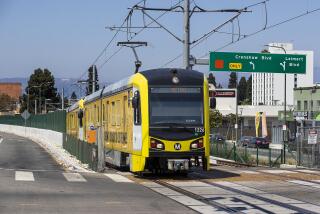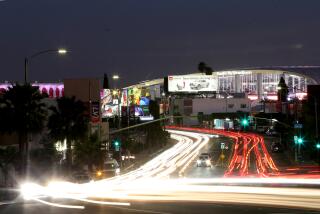On the Ground: Seattle continues quest to get greener as it grows with ‘transformative’ light-rail expansion
Reporting from SEATTLE — It is just a modest extension — two stations added to 13 others already in existence on a line that serves a tiny fraction of the population in one of the nation’s fastest-growing cities.
But you could be forgiven for thinking that the recent opening of the Capitol Hill and University of Washington light-rail stations here marked something more than just an incremental moment in the history of public transportation.
Families, curious commuters and transit enthusiasts filled the new platforms on the Saturday the stations opened. Musicians played, public art made its debut and, at least for a day, admission was free.
The following workweek, overall ridership on the system, called Link, soared more than 50% on some days — from about 35,000 daily riders the week before to a peak of 57,000 the Tuesday afterward. Before the week was out, Sound Transit, which operates the system, announced that it would add rail cars.
“The U Link really is transformative,” Jon Talton, a local economics columnist, wrote on Twitter. “As someone else said, I finally feel like I’m living in a big city (in a good way). So easy.”
As someone else said, I finally feel like I’m living in a big city (in a good way).
— Jon Talton, Seattle economics columnist, in a tweet
Seattle, surrounded by natural beauty and filled with ambition, has struggled for years to answer questions that go to the heart of what will become of this planet: Can a big city get bigger — and greener — at the same time?
Over the last decade, Seattle has pledged to reduce its carbon emissions, been a national leader in recycling and composting, and banned stores from using plastic grocery bags. It has built two new streetcar lines, created an express bus system, installed miles of new bike lanes, overseen the launch of a bike-sharing system (buying it outright when it floundered), and built the starter leg of the light-rail network. The first 13 stops opened in 2009.
See more of our top stories on Facebook >>
At the same time, the city has welcomed a startling wave of development that has remade a section of downtown into a gleaming grid of offices and apartments built to accommodate the growth of technology companies and young workers who apparently want their future to be pedestrian-friendly and unpolluted. Amazon, which is based here, started the latest rush, but Facebook, Expedia and Google all have announced big plans to grow as well.
“We’re looking forward to walking, biking and riding the streetcar through the neighborhood,” Clyde McQueen, a top Google executive in Seattle, said in announcing plans to build two office complexes.
Much of the growth is near Lake Union, the city’s freshwater piazza, where seaplanes “land,” the Space Needle looms and a handful of old houseboats remain ungentrified, evoking a nearly lost Northwest decay. It feels like no other place in America. It feels authentic. Developers say millennials like that.
Yet the green dream is complicated. The city, in many minds, has become a mess of cranes, construction and people with dubious commitments to the greater good. Making things worse, for three years now it has been at the mercy of an unpredictable beast lurking beneath it.
They call her Bertha. She is the largest boring machine in the world — on a problem-plagued, start-stop journey to drill a highway tunnel under the city. She is also a symbol of defeat for transit advocates who fought the project on the grounds that it would lead only to more automobile traffic — and therefore more carbon emissions. Her opponents included former Mayor Mike McGinn, a Sierra Club leader and political neophyte who peddled public transit and bike lanes, not a highway tunnel. His nickname was Mayor McSchwinn, and he lasted one contentious term.
But as Bertha muddles mysteriously along, other tunnels have been drilled more efficiently. The two new light-rail stations opened on time and under budget, extending the system to about 19 miles. It runs above and below ground as it makes its way from the university through downtown to Seattle-Tacoma International Airport. By 2021, three more stations are to open farther north, and by 2023 another set will push into suburbs to the north, south and east.
This fall, Sound Transit plans a blockbuster ballot measure to ask voters for as much as $50 billion — increasing taxes nearly $400 per year for an average household — to expand the system into more Seattle neighborhoods and surrounding cities. Voters approved much of the current construction in 2008.
“In 2008, we were having to argue about the benefits of more transit and light rail,” said Bruce Gray, a spokesman for Sound Transit. “Today, the argument is about how fast it can be built. The question has really shifted from why to how much and how fast.”
That may simplify things a bit.
The light-rail system opened in 2009 to something less than euphoria, and ridership fell short of early Sound Transit projections. Public transit has also underperformed in Los Angeles and some other cities in recent years. Critics say Seattle should not build more until its current plan fulfills expectations.
But supporters believe rising ridership from the new stations will help make the case for expansion. The Capitol Hill and University of Washington stations enable commuters to go below ground to bypass a notorious series of bottlenecks and bridges above. They also happen to serve dense areas that are home to a well-educated, environmentally minded demographic — one that has aspirations.
“Subways,” said Emnet Gossaye, a 22-year-old senior at the university who plans to work after graduation in information technology at Starbucks, whose headquarters are across town but convenient to Link, “are a big part of many great cities.”
ALSO
Library of Congress to stop using term ‘illegal alien’
Native American casino plan wagers on tiny Illinois town
Pot sales healing economic woes of the Colorado town of DeBeque
More to Read
Sign up for Essential California
The most important California stories and recommendations in your inbox every morning.
You may occasionally receive promotional content from the Los Angeles Times.











